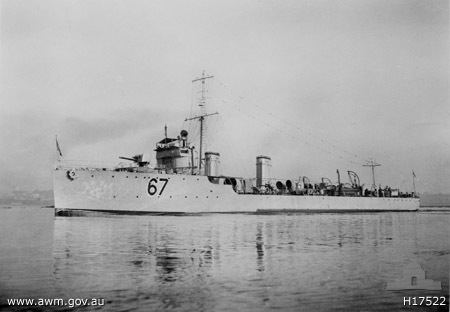Completed 6 Displacement 750 tons | In commission 1910–1930 Type Torpedo-boat destroyer | |
 | ||
Name River-class torpedo-boat destroyer | ||
The River class was a class of six torpedo-boat destroyers operated by the Royal Australian Navy (RAN). Based on the British Acheron class, a batch of three ships was ordered for the Commonwealth Naval Forces in 1909, followed later by a second batch of three. All six vessels are named after Australian rivers.
Contents
The Rivers saw service during World War I. Ships of the class participated in the Australian Naval and Military Expeditionary Force capture of German New Guinea, and performed patrols in Australian and Malayan waters. In 1917, the class was deployed as a single unit to the Mediterranean, and assigned to anti-submarine patrols of the Adriatic. The destroyers returned to Australia in 1919, and were placed in reserve.
All six ships of the class were disposed of by the 1930s. Three were sold for use as accommodation hulks (two to the NSW Penal Department, the third to Cockatoo Island Dockyard) and later sank. The other three were sunk as target ships. The bow and stern sections of HMAS Parramatta were recovered in 1973 and are preserved as memorials.
Design and construction
Based on the British Acheron class, the destroyers of this class had a displacement of 750 tons. The first three had a length overall of 246 feet (75 m), while the second three were longer at 250 feet 9 inches (76.43 m). They were powered by three oil-burning Yarrow boilers connected to Parsons turbines, which delivered 10,000 shaft horsepower (7,500 kW) to three propeller shafts. Cruising speed was 11.5 knots (21.3 km/h; 13.2 mph), giving the ship a range of 2,690 nautical miles (4,980 km; 3,100 mi), and maximum speed was 26 knots (48 km/h; 30 mph). Each ship's company consisted of between 66 and 73 personnel, including five officers. The destroyers' main armament consisted of a single BL 4-inch Mark VIII naval gun, supplemented by three QF 12 pounder 12 cwt naval guns. They were also fitted with three .303-inch machine guns and three single 18-inch torpedo tubes.
The first three ships, Parramatta, Yarra and Warrego, were ordered for the Commonwealth Naval Forces (the post-Federation amalgamation of the Australian colonial navies) on 6 February 1909. Another three ships, Huon, Swan, and Torrens, were ordered later. On the advice of the British Admiralty, the ships were named after Australian rivers (one from each state), although the original intention of using rivers with Aboriginal name origins did not carry through to the second batch. Senator George Pearce requested that they instead be named after famous navigators, but was overruled by Prime Minister Alfred Deakin. Huon was originally to be named Derwent, but this was changed before launch to avoid confusion with the British E-class (formerly River-class) destroyer HMS Derwent.
Parramatta and Yarra were the first new ships launched for the Australian navy. After completion, the two vessels were temporarily commissioned into the Royal Navy for the delivery voyage to Australia, although they reverted to the control of the Commonwealth Naval Forces on arrival in Broome. Warrego, however, was built up to launch condition, then disassembled, transported to Australia by ship, and rebuilt at Cockatoo Island Dockyard: the reasoning behind this was to raise the standard of the Australian shipbuilding industry by giving Cockatoo Island hands-on experience in warship construction. The second batch of three warships were all built at Cockatoo Island.
Operational history
The first three destroyers were operating with the Australian fleet at the start of World War I. The three ships were assigned to the Australian Naval and Military Expeditionary Force, and participated in the capture of German New Guinea. After the conclusion of the campaign, the destroyers were assigned to home waters for a short period, then assigned to Malayan and surrounding waters until late 1916. During August and September, the second group of River-class destroyers began relieving the ships of the first group from Malayan patrols, with Parramatta, Yarra, and Warrego returning to Australia.
In July 1917, all six ships rendezvoused off the Cocos Islands: the first time the entire class had been in one location. From there, the River-class destroyers proceeded to the Mediterranean. On arrival at Malta, they were immediately deployed as escorts for a convoy. After this, the destroyers were modified for anti-submarine warfare: the aftmost torpedo tube was removed and replaced with depth charge rails. From August 1917, the six destroyers were based at Brindisi, Italy, assigned to patrol the Adriatic and prevent enemy submarines using it as a route to the Mediterranean.
After a brief refit and leave period in England after the war's end, and the re-installation of their torpedo tubes at Malta, the six destroyers returned to Australian waters in March 1919. They were placed in reserve, and had all been disposed of by the 1930s.
Decommissioning and fate
After decommissioning, Parramatta and Swan were stripped down and sold to the NSW Penal Department for use as prisoner accommodation on the Hawkesbury River. The two hulks were then sold into private hands; after plans to use them as fishers' accommodation, they were used to transport metal to islands along the river. In 1934, Swan and Parramatta were being towed along the river to the ship breakers when heavy weather caused the hulks to break free of their towing vessel; Swan sank, and Parramatta ran aground. The two ships were abandoned, although in 1973, the bow and stern of Parramatta were salvaged for use as memorials.
Warrego was used as accommodation at Cockatoo Island. She sank at her berth, and was later demolished. Yarra, Torrens, and Huon were all scuttled outside Sydney Heads after being used as target ships.
